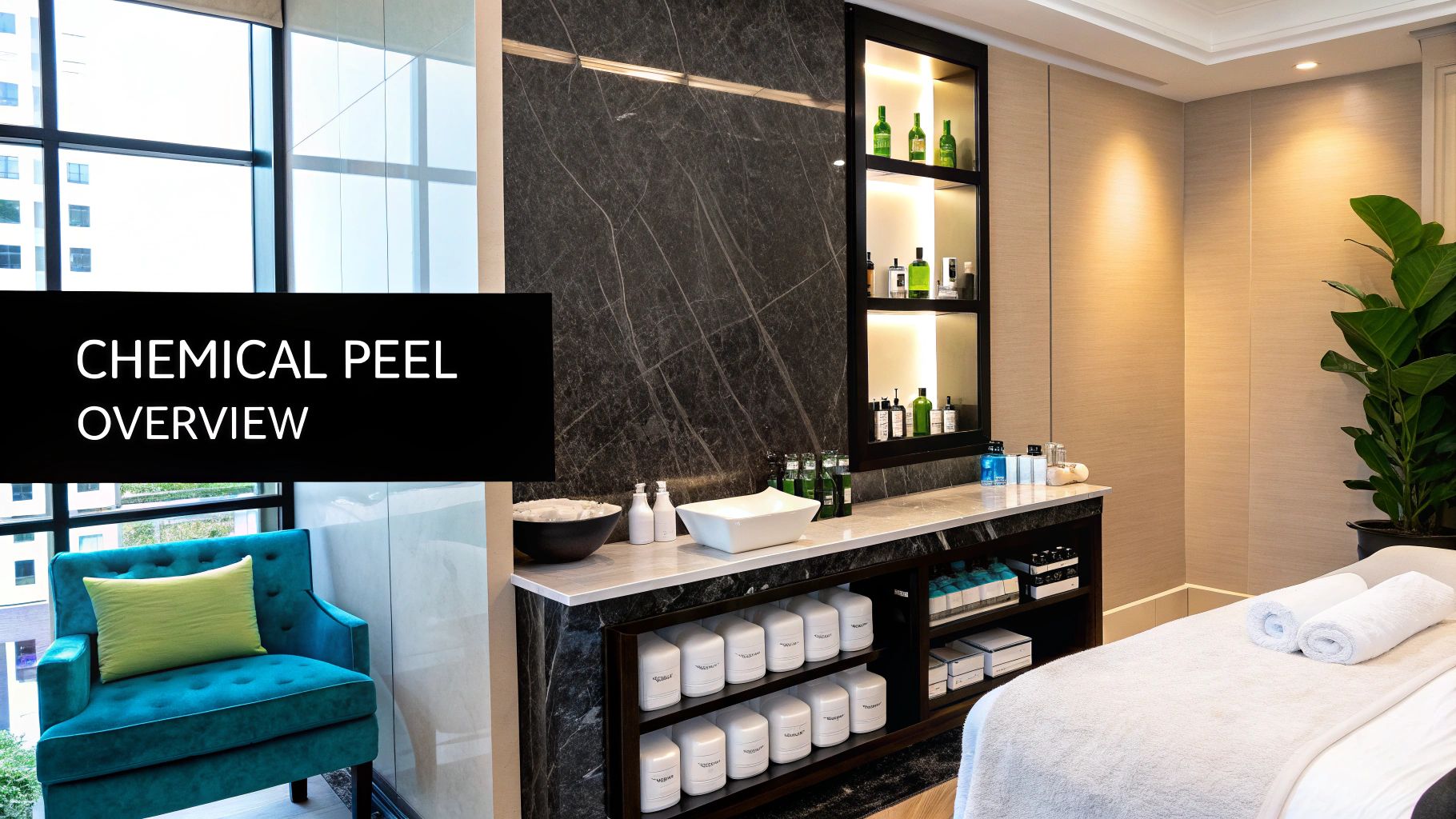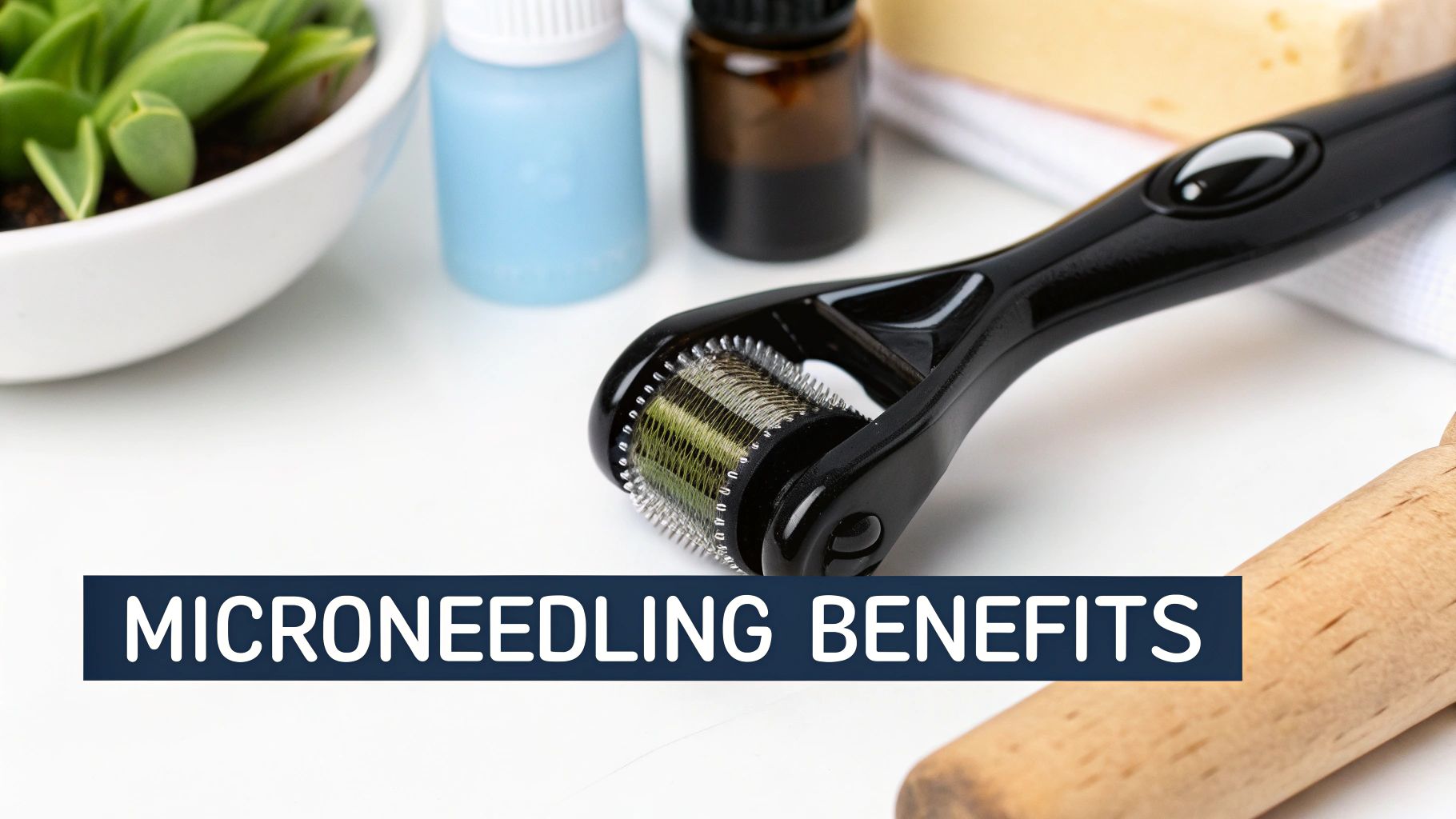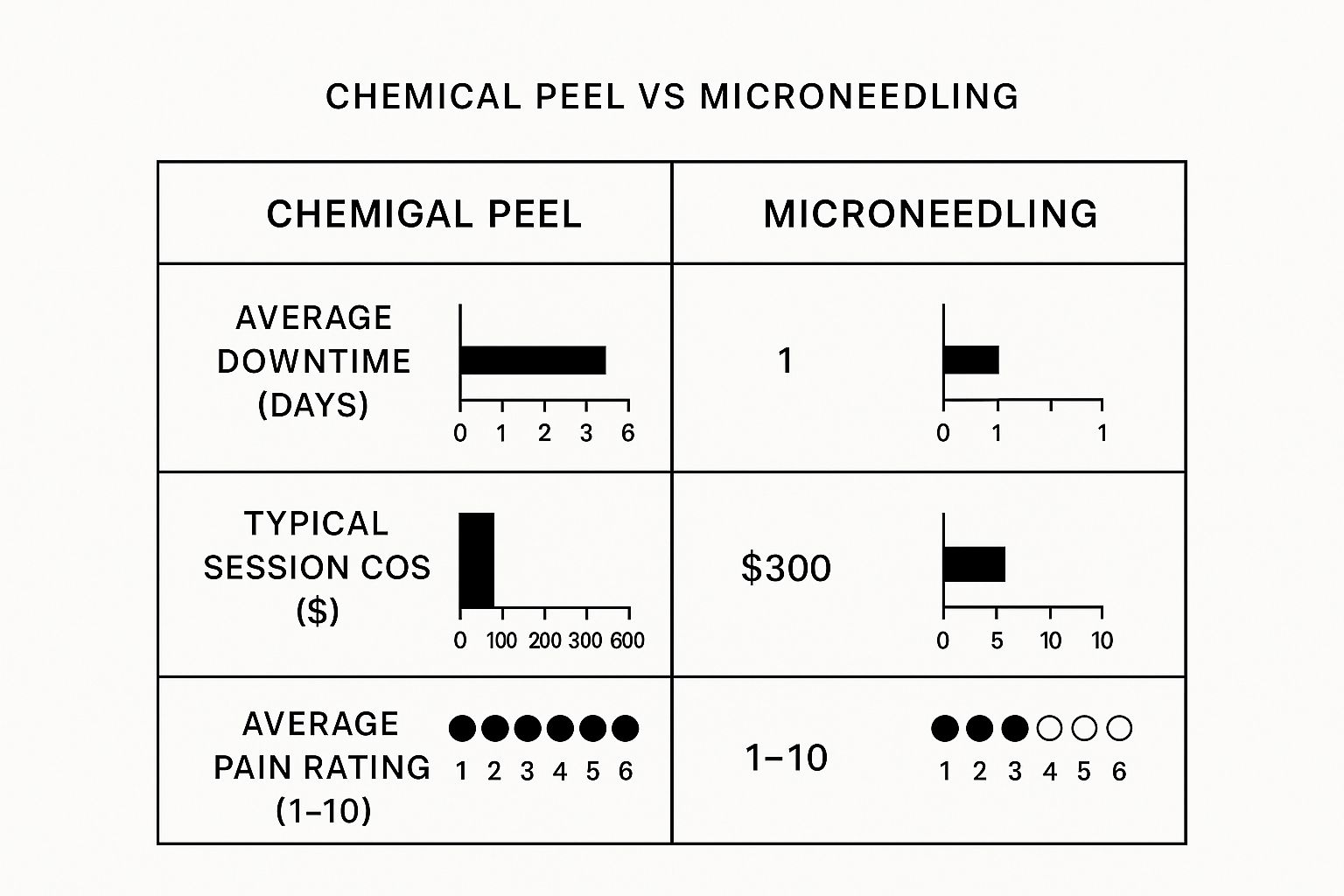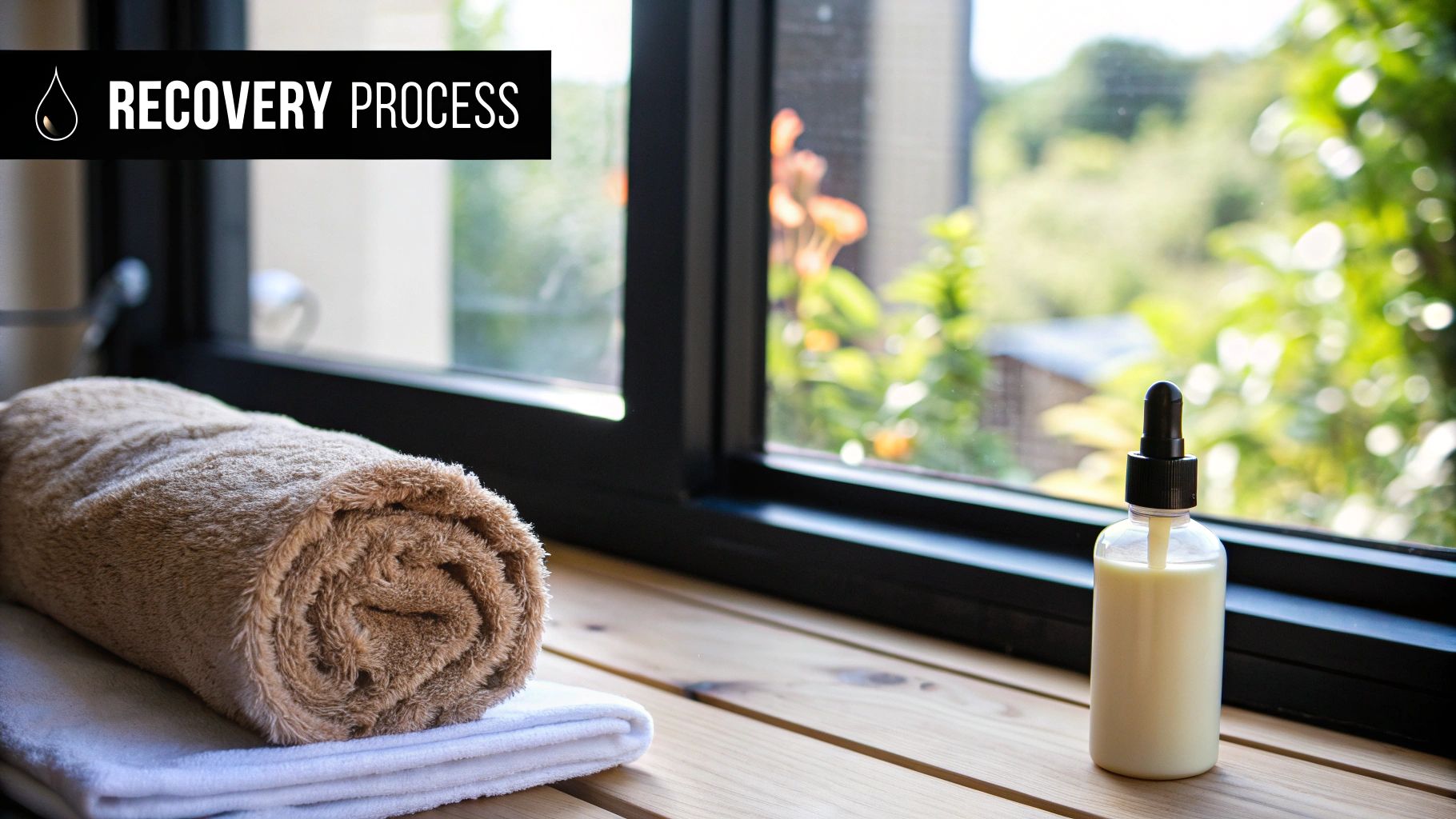Chemical Peel vs Microneedling for Flawless Skin
- Blog Admin

- Jul 24
- 15 min read
Trying to pick between a chemical peel and microneedling? The right answer really comes down to what your skin needs right now.
Chemical peels are fantastic for tackling surface-level problems like sun damage or patchy pigmentation because they work by exfoliating the top layer of skin. On the other hand, microneedling gets to work on a deeper level, prompting your own body to produce more collagen to fix things like acne scars and improve your skin's firmness.
This guide will help clear up the whole chemical peel vs microneedling question. Here at Skinsation Aesthetics in London, Ontario, we’re experts in both treatments and can help you make a smart choice based on a proper professional look at your skin.
Unpacking the Core Differences
When you’re looking to give your skin a fresh start, the first step is knowing how each treatment actually works. While both chemical peels and microneedling are designed to give you a better complexion, they go about it in completely different ways. One is an "outside-in" job, and the other is an "inside-out" one.

Think of a chemical peel as a controlled way to renew your skin's surface. It uses a specific solution to dissolve the gunk that holds dead, dull skin cells together. This process basically resurfaces your skin, showing off the brighter, fresher layer just waiting underneath. This makes it a real powerhouse for issues that live on the skin's surface.
Microneedling, however, is all about rebuilding your skin’s underlying structure. By creating thousands of tiny, controlled micro-channels in the skin, it flips the switch on your body's natural healing process. This kicks collagen and elastin production into high gear, repairing the skin from within to sort out texture issues like scars and deeper lines.
Key Takeaway: Chemical peels refine the skin's surface, while microneedling rebuilds the skin's structure. Your main skin concern—whether it's surface discolouration or deeper texture—is the biggest factor in deciding which way to go.
Quick Comparison Chemical Peel vs Microneedling
To help you see the differences at a glance, here’s a direct comparison of how each treatment works and what it's best for. This table lays out the core mechanics that really set them apart.
Ultimately, choosing between a chemical peel and microneedling isn't about which one is "better" in general, but which one is better for you. As a premier beauty spot in London, Ontario, Skinsation Aesthetics offers both of these advanced services. A consultation can help figure out the perfect treatment plan for your specific skin goals, making sure you put your money into the procedure that will get you the results you’re dreaming of.
How Chemical Peels Reveal Brighter Skin
Think of a chemical peel as a powerful reset button for your face. It’s a treatment that uses a specialized acid solution to gently dissolve the "glue" holding dull, dead skin cells to the surface. By clearing away that old layer, it reveals the brighter, smoother complexion hiding underneath. It's a professional form of chemical exfoliation that really gets the job done.
Imagine your skin is like a brick wall. The dead cells are the old, discoloured bricks, and they're held together by a sort of natural mortar. A chemical peel works by breaking down that mortar, allowing us to sweep away those old bricks and reveal a fresh, new surface.
Here at Skinsation Aesthetics in London, Ontario, we know that every client's skin is unique. That’s why we customize our chemical peel treatments, making sure the type and strength of the peel are a perfect match for your skin type and what you're hoping to achieve.
Understanding Different Peel Strengths
Not all chemical peels are the same. They come in different intensities to target different skin concerns, and the main difference is how deep the solution goes.
Superficial (Light) Peels: These are the mildest peels, often using Alpha-Hydroxy Acids (AHAs) like glycolic acid or Beta-Hydroxy Acids (BHAs) like salicylic acid. They work right on the surface layer (the epidermis) and are great for minor issues like rough texture, slight discolouration, and fine lines.
Medium Peels: Using acids like Trichloroacetic Acid (TCA), these peels go a little deeper into the upper part of the dermis. They're much more effective for tackling moderate sun damage, more stubborn pigmentation, and noticeable wrinkles.
Deep Peels: These are the most intense peels and are reserved for serious textural problems like deep-set wrinkles or certain types of scars. Because of their intensity, they require significant downtime and are performed under very specific medical supervision.
The secret is choosing the right depth for your goals. A light peel is fantastic for a quick refresh and getting that glow back, but a medium peel is what you need for more significant correction of stubborn surface issues.
What to Expect During a Session
When you come in for a chemical peel, the first thing we do is give your skin a thorough cleansing. Then, the chemical solution is carefully brushed onto your skin and left on for a specific amount of time, depending on the peel's strength and how your skin is reacting. It’s totally normal to feel a bit of a tingling, stinging, or warm sensation while it's working.
After the peel is neutralized and removed, your skin might look a little pink or red, almost like you got a bit of sun. This is temporary and just the first sign that the renewal process has started. While costs can change depending on where you are in Canada and the type of peel, it’s a very accessible treatment. For example, in Canada, a light chemical peel can cost around $150 to $300 per session. You can find more details on these cost factors and financing options on CareCredit.com.
Ultimately, a chemical peel's job is to kickstart your skin's natural healing response, encouraging it to generate new, healthier cells. Whether you’re dealing with sun spots or just want a brighter, more even tone, this treatment is a direct path to resurfacing your skin. To find out if it's the right choice for you, you can explore the details of the [chemical peels available at Skinsation Aesthetics](https://www.skinsation.me/chemical-peel).
How Microneedling Rebuilds Skin From Within
While a chemical peel works its magic on the skin's surface, microneedling goes much deeper. It’s a completely different philosophy, focused on rebuilding your skin's foundational structure from the inside out.
We often call it collagen induction therapy, and that name says it all. The treatment uses your body's own incredible healing powers to create stronger, healthier, and smoother skin. For any skin issues that seem to be rooted deep down, this is almost always the better choice.

Here's how it works: we use a specialized device with ultra-fine needles to create thousands of tiny, controlled punctures in the skin. These micro-channels are so small they're practically harmless, but they're just enough to trick your body into launching its wound-healing response. This is precisely what we want! It signals your system to flood the area with new collagen and elastin—the proteins that give your skin that firm, elastic, youthful bounce.
This "inside-out" repair makes microneedling incredibly effective for stubborn textural problems that surface-level treatments just can't touch.
What Microneedling Targets Best
Because microneedling stimulates repair at such a deep level, it’s our go-to solution for very specific skin concerns. It is especially effective for:
Atrophic Acne Scars: Those are the indented or "pitted" scars left behind by severe acne. Microneedling helps fill them in by building new collagen right underneath the depression.
Stubborn Wrinkles: By restoring the skin's underlying support network, it visibly smooths out deeper lines and wrinkles over several sessions.
Enlarged Pores: The new collagen helps tighten and firm the skin surrounding your pores, making them appear smaller and far less noticeable.
Stretch Marks: Much like with acne scars, microneedling can improve the texture and even the colour of stretch marks by encouraging new tissue to grow.
Here at Skinsation Aesthetics in London, Ontario, our focus is on delivering these kinds of lasting, structural improvements. Our goal is to help you build a stronger, healthier skin foundation for the long term.
Think of it like this: if a chemical peel is like polishing a marble countertop to restore its shine, microneedling is like repairing the cracks in the foundation of the house. Both are important, but they tackle fundamentally different problems.
The Client Experience From Start to Finish
For many of our clients, knowing exactly what to expect during the treatment itself is key. The [microneedling procedure at Skinsation Aesthetics](https://www.skinsation.me/microneedling) always starts with a thorough cleansing of your skin, followed by a topical numbing cream. This step is crucial to make sure the treatment is comfortable and virtually painless.
Once the numbing cream has worked its magic, our trained aesthetician will glide the microneedling device across the targeted areas. The session itself is pretty quick, usually taking about 20-30 minutes. Afterwards, your skin will likely look and feel like it has a mild sunburn. This is a normal, temporary reaction that typically fades within a day or two.
As for cost, microneedling prices can vary quite a bit depending on where you are in Canada and what the treatment includes. Standard microneedling sessions in Canada can range anywhere from $300 to $750. That range shows just how customizable the treatment can be—options like adding radiofrequency or specialized serums will be at the higher end of the scale.
Ultimately, microneedling is a powerful investment in your skin's future health, offering gradual but profound improvements that truly last.
Comparing Downtime, Recovery, and Results
When you're trying to decide between a chemical peel and microneedling, it’s the practical stuff that often makes the difference. Your lifestyle, social calendar, and work commitments here in London, Ontario, will really guide which treatment is the better fit. It often comes down to this: are you looking for a quick fix or a long-term investment in your skin's health?
One of the biggest differences is the recovery process. Microneedling is known for its minimal social downtime. Most people just look like they have a mild sunburn, and that redness typically fades within 24 to 48 hours. This makes it super easy to squeeze into a busy schedule without much disruption.
On the other hand, the downtime for a chemical peel is all about its strength. A light, superficial peel might just cause a bit of flaking for a few days. But a medium-depth peel? That's a different story. You can expect more significant peeling and redness for up to a week, which definitely requires some planning around your work and social life.
The Timeline of Results
How soon you see changes is another major point that sets these treatments apart. A chemical peel often gives you that instant gratification, especially for things on the skin's surface.
Chemical Peel: You'll often see a brighter, more radiant complexion as soon as that initial peeling is done. It’s fantastic for a quick refresh to even out your skin tone and get a visible glow.
Microneedling: The results here are more gradual, building up over time. You might notice an initial "glow" from some temporary swelling, but the real magic—that deep collagen remodelling—happens over the next 4 to 6 weeks. The full benefits for smoothing out texture and improving firmness really show after a few sessions.
A chemical peel is like a rapid surface renewal, making it a great choice before a big event. Microneedling offers a deep, long-term textural change that builds over months. Think of it as polishing the surface versus rebuilding the foundation.
This handy chart breaks down the key details like downtime, cost, and comfort for each treatment.

As you can see, while both treatments are rated similarly for pain, microneedling generally has less downtime. Chemical peels have a much wider range for both recovery time and cost, depending on how intense you go.
The Nature of Skin Improvement
The type of improvement you get is another critical factor in the chemical peel vs. microneedling debate. At its core, a chemical peel is an exfoliating and resurfacing treatment. It’s brilliant at lifting away discolouration, sun damage, and rough patches from the top layer of your skin.
Microneedling, however, is all about regeneration. By creating tiny channels to kickstart deep collagen production, it actively helps repair structural problems like indented acne scars, enlarged pores, and saggy skin. The improvement comes from strengthening the skin from the inside out, not just refining what you see on top. While peels can also stimulate some collagen, microneedling's main job is this rebuilding process.
If you're leaning towards a peel, it's good to know how it stacks up against other resurfacing options. You might find our guide on microdermabrasion vs. chemical peel helpful, as it dives into another popular exfoliating treatment.
Ultimately, the best choice boils down to your main goal. Are you after a quick path to a more even-toned, glowing surface? Or are you playing the long game to smooth out deep-set texture and bring back that youthful firmness? Your answer will point you to the right procedure for your skin's unique needs. A consultation here at Skinsation Aesthetics can give you that professional assessment to make sure your choice perfectly matches the results you’re hoping for.
Choosing the Right Treatment for Your Skin Goals
Deciding between a chemical peel and microneedling really comes down to one simple question: what is your number one skin priority? Each treatment gets you to that rejuvenated look through a completely different path, so the right choice is all about the specific results you want to see in the mirror. This is where we get practical.
Think of it like choosing the right tool for a specific job. You wouldn't use a paintbrush to hammer a nail, right? In the same way, getting the most out of your skincare investment means matching the treatment's strengths to your unique skin concerns.

For Surface-Level Concerns Like Tone and Pigment
If your main goal is to tackle issues on the skin’s surface, a chemical peel is almost always your most direct route. It truly excels at correcting problems that live in the epidermis—the very top layer of your skin.
A chemical peel is often the hero for these common Canadian skin concerns:
Sun Damage and Sun Spots: All those years enjoying our Canadian summers can leave behind spots and discolouration. A chemical peel works by gently lifting away those sun-damaged cells, revealing a much brighter, more even complexion.
Dullness and Uneven Skin Tone: Does your skin just look tired and lack that healthy glow? A peel can give it a quick refresh. By sloughing off that top layer of dead, dull cells, it instantly boosts radiance and evens out your overall tone.
Active Acne and Clogged Pores: Certain peels, especially ones using salicylic acid (a BHA), are fantastic for getting deep into pores to clear out gunk and calm the inflammation that comes with active breakouts.
Scenario: If you look in the mirror and your biggest frustration is patchiness, sun spots, or a dull texture that makeup just can't hide anymore, a chemical peel is designed to target exactly that. It's all about refining the canvas.
For anyone in London, Ontario, considering this path, a personal consultation is everything. At Skinsation Aesthetics, we customize our chemical peel treatments to your specific type of discolouration or acne, ensuring you get a targeted and effective approach.
For Deeper Structural and Textural Issues
On the other hand, if your concerns are rooted deeper within the skin's structure, microneedling is hands-down the better choice. This procedure is all about remodelling the skin from the inside out, making it the champion for textural problems and loss of firmness.
Microneedling delivers the deep repair needed for lasting change in these situations:
Atrophic Acne Scars: Those indented or "pitted" scars from old breakouts need more than just surface exfoliation. Microneedling kicks off new collagen production right under the scar, helping to plump up the depression from below and create a smoother surface over time.
Fine Lines and Deeper Wrinkles: By rebuilding the skin’s foundational collagen and elastin network, microneedling restores firmness and plumps the skin from within, which effectively softens the look of lines and wrinkles.
Enlarged Pores: While a peel helps clear out pores, microneedling actually improves their appearance by tightening the skin around them. The new collagen acts like a support structure, making the pore walls firmer and visibly smaller.
Scenario: If you run your fingers over your skin and feel the uneven texture of old acne scars, or you're noticing your skin doesn't have that youthful "bounce" anymore, microneedling is the treatment that rebuilds that structural integrity. It's about strengthening the foundation.
In the chemical peel vs microneedling debate for these deeper issues, microneedling is almost always the winner. It's a powerful investment in your skin's long-term health. The microneedling services we offer at Skinsation Aesthetics are focused on creating these kinds of meaningful, structural improvements. A professional assessment will help us see if your skin goals line up with this regenerative path, setting you up for results that are truly more than skin deep.
Combining Treatments for Maximum Impact
Why pick just one? For clients who are serious about skin rejuvenation, a 'power-duo' approach that strategically combines a chemical peel and microneedling can deliver results that neither treatment could ever achieve on its own. It's an advanced strategy, but it's perfect for tackling multiple concerns at once—from surface-level imperfections to deeper structural issues.
Think of it like this: a light chemical peel is the ultimate prep step. It whisks away the superficial layer of dead, dull skin cells sitting on the surface. By clearing the path, the microneedling treatment that follows can get deeper into the dermis, where it can really work its collagen-stimulating magic.
This one-two punch is especially powerful for complex skin challenges where both skin tone and texture are a problem.
The Synergy of a Combined Approach
Now, combining these treatments doesn't mean doing them on the same day. It's a carefully timed protocol designed by a skincare professional to get the most out of both procedures. The whole process is built around the unique strengths of each service.
Step 1: The Peel: A light chemical peel goes first, taking care of surface-level issues like pigmentation, fine lines, and dullness. This creates the perfect canvas.
Step 2: Microneedling: A few weeks later, after your skin has fully healed from the peel, microneedling gets to work on that freshly revealed skin. Its focus is on building deep collagen to improve scars, firmness, and more stubborn wrinkles.
This method creates a real synergistic effect—the total result is far greater than the sum of its parts. Clinical research backs this up, showing that using both treatments leads to more significant improvements. For example, studies have looked at how microneedling combined with solutions like Jessner's and TCA peels can supercharge skin rejuvenation, leading to faster improvement in acne scars and wrinkles compared to just using one method. You can find out more about the efficacy of combination therapies from this LWW Journals study.
Important Note: This is an advanced treatment plan that must be performed by a qualified professional. The timing, the strength of the peel, and the depth of the microneedling all need to be customized for your skin to be safe and effective.
Is This Power-Duo Right for You?
This combined strategy is really for individuals with multiple, overlapping skin concerns who are committed to seeing significant, lasting change. If you're here in the London, Ontario area and dealing with a mix of sun damage, uneven texture, and a loss of firmness, this could be the ultimate solution for you.
At Skinsation Aesthetics, creating personalized treatment plans is what we do best. During a consultation, we can assess if your skin is a good candidate for this powerful combination and make sure the protocol is tailored to your unique goals for truly remarkable results.
Your Questions, Answered
When you're looking into advanced skin treatments, it's natural to have a few questions. We get it. Here are some straightforward answers to the questions we hear most often from our clients in London, Ontario, and across Canada who are trying to decide between a chemical peel and microneedling.
What's the Typical Cost in Canada?
The price for both chemical peels and microneedling really depends on where you are in Canada, the clinic's reputation, and what your specific treatment plan looks like. But to give you a general idea, here’s what you can expect:
Chemical Peels: A lighter, surface-level peel might start around $150-$250 per session. If you’re looking at a more intense medium-depth peel, prices usually climb to between $300 and over $600, depending on the acids used.
Microneedling: A standard microneedling session in Canada typically falls in the $300 to $750 range. This cost can go up if you add on extras like radiofrequency or specialized serums to boost your results.
Here in London, Ontario, prices are quite competitive. The best way to know for sure is to book a professional consultation where we can take a close look at your skin and give you an exact quote.
Can I Get These Treatments if I Have Sensitive Skin?
This is a really important question, and the answer isn't a simple yes or no. While both treatments can often be adjusted for different skin types, you absolutely have to be careful if you have sensitive skin or conditions like rosacea or eczema.
A chemical peel might be too much for highly reactive skin and could cause irritation. On the other hand, microneedling can sometimes be a safer bet because it doesn’t involve chemicals that could trigger a reaction. We can also adjust the needle depth to be very superficial. If you're having an active flare-up of rosacea or eczema, however, both treatments are off the table until it calms down.
Honestly, a thorough skin analysis with a trained aesthetician is non-negotiable. It’s the only way to know for sure if you're a good candidate.
How Many Sessions Will I Need to See Real Results?
You're almost never going to get the results you want from just one session. Great skincare is a journey, not a destination. How many appointments you'll need really comes down to your main skin concern, how severe it is, and what your end goals are.
Typically, a treatment plan might look something like this:
For Chemical Peels: To tackle issues like hyperpigmentation or fine lines, we usually recommend a series of 3 to 6 peels. These are spaced about 4 to 6 weeks apart to give your skin time to heal and regenerate.
For Microneedling: If you want to really improve acne scars or wrinkles, a course of 3 to 6 sessions is the standard. We also space these 4 to 6 weeks apart, which allows your skin to build up all that new collagen between treatments.
At the end of the day, the best strategy is always one that’s made just for you.
At Skinsation Aesthetics, we believe in building a treatment plan that’s perfectly suited to your skin's unique needs. A professional consultation is the first step toward figuring out which procedure—or maybe even a combination of them—will give you the beautiful, healthy skin you’re looking for. Book your appointment today and let us guide you on your journey to glowing skin. Find out more by visiting us at https://www.skinsation.me.


Comments